The Honduran lempira (HNL) is the official currency of Honduras, and it has a fascinating history that dates back to the 19th century. The currency has gone through many changes over the years, and understanding its history can help you better appreciate the country’s culture and economy.
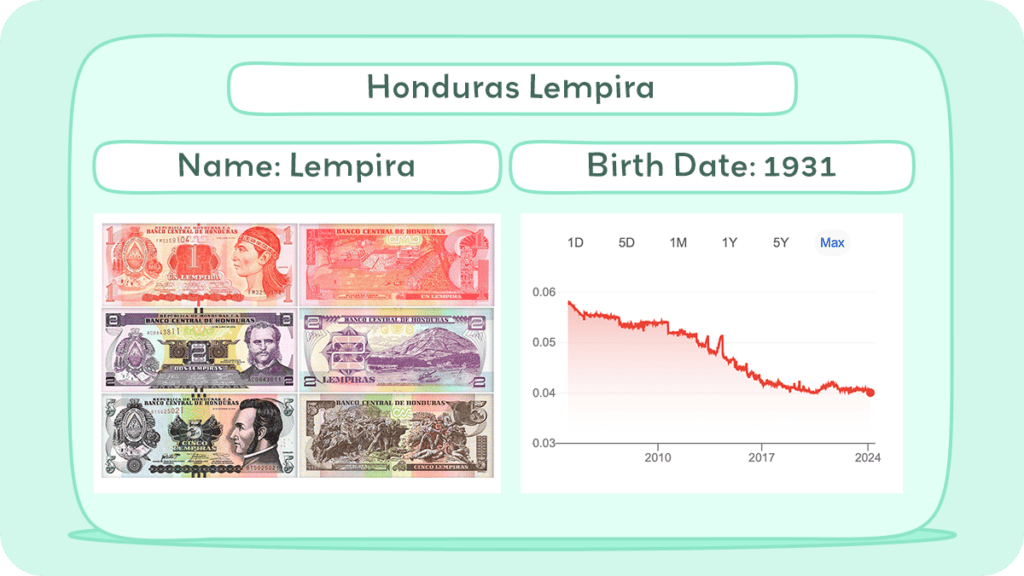
The Honduran lempira is divided into 100 centavos, and there are currently eight denominations of banknotes in circulation: 1, 2, 5, 10, 20, 50, 100, and 500 lempiras. There are also coins in denominations of 5, 10, 20, and 50 centavos, as well as 1 and 2 lempiras.
Understanding the Honduran lempira is crucial when traveling or conducting business in Honduras. By familiarizing yourself with the banknotes and coins, exchange rates, and acceptance of currency, you can ensure that your transactions go smoothly and avoid any potential issues.
Historical Journey of Honduras Currency
The Honduran lempira (HNL) has a rich history that dates back to 1931 when it replaced the Honduran peso at par. The currency is named after the indigenous leader Lempira who fiercely resisted Spanish conquest. Since then, the currency has undergone several changes, reflecting the nation’s journey from colonial rule to a sovereign state.
The currency, which has been free-floating and experiencing a steady decline in value against the U.S. dollar over recent years, reflects the economic challenges of Honduras.
This country, with a history marked by political instability and economic vulnerability due to its reliance on commodity exports like bananas and silver, remains one of the poorest in the Western Hemisphere.
During the 1980s, the Honduran economy suffered from hyperinflation, which severely impacted the buying power of the currency.
Inflation rates soared to over 30,000%, leading to the introduction of a new currency, the lempira fuerte (HNL-F), in 1994. The new currency was equivalent to 1,000 old lempiras, and the government set a fixed exchange rate of 1 HNL-F to 1 US dollar.
Despite these efforts, the Honduran currency has continued to face challenges in maintaining its value. The country’s economy remains heavily dependent on agriculture, with coffee and bananas being the main exports.
Fluctuations in commodity prices, natural disasters, and political instability have all contributed to the currency’s volatility.
The introduction of polymer banknotes and the centralization of the monetary system under the Central Bank in the mid-20th century were key developments in the country’s financial history.
Honduras’ economy, characterized by a low middle-income status with modest GDP growth and an inflation rate as reported by the World Bank, illustrates the ongoing struggle for stability and growth amidst historical and environmental adversities.
Today, the Honduran lempira remains the official currency of Honduras, with one lempira being equivalent to $0.041 US dollars. While the currency has struggled with inflation and devaluation in the past, recent years have seen stability in the exchange rate, providing some relief to the country’s economy.
History of Coins
In 1931, Honduras introduced coins in denominations including 5, 20, and 50 centavos, and 1 lempira, expanding the range in the following years with 1, 2, and 10 centavos coins.
The production of silver 1 lempira coins ended in 1937, and by 1967, the 20 and 50 centavos coins transitioned from silver to cupro-nickel.
The minting of 1 and 2 centavos coins ceased in 1998 and 1974, respectively. Currently, coins in circulation include 5, 10, 20, and 50 centavos.
History of Bills
The first lempira banknotes were issued in 1932 by the Bank of Honduras and Banco Atlántida in denominations from 1 to 20 lempiras.
The Central Bank of Honduras assumed responsibility for paper money in 1950, introducing higher denominations over time, including a 500-lempira note in 1995 and a polymer-based 20-lempira note in 2010.
Celebrating the bicentennial anniversary of Honduras’s independence, a new 200 lempira note featuring scarlet macaws was issued.
Banknotes currently in use are in denominations of 1, 2, 5, 10, 20, 50, 100, 200, and 500 lempiras, each with distinct colors and designs representing Honduran history and culture.
Inflation and Buying Power of the Honduran Lempira
The Honduran lempira (HNL) has experienced significant inflation in recent years, with an average inflation rate of 3.7% between 2010 and 2020.
This inflation has led to a decrease in the buying power of the currency, meaning that the same amount of money can buy fewer goods and services than it could in the past.
To combat this inflation, the Central Bank of Honduras has implemented various measures, such as increasing interest rates, to stabilize the value of the lempira. However, the effectiveness of these measures remains to be seen.
Overall, while the Honduran lempira has experienced inflation in recent years, it still retains some buying power. The Central Bank of Honduras continues to take measures to stabilize the currency, but the effectiveness of these measures remains uncertain.
Honduran Lempira
The current banknotes in circulation include denominations of 1, 2, 5, 10, 20, 50, 100, 200, and 500 lempiras, each with unique colors and designs showcasing significant aspects of Honduran history and culture on both the obverse and reverse sides.
1L
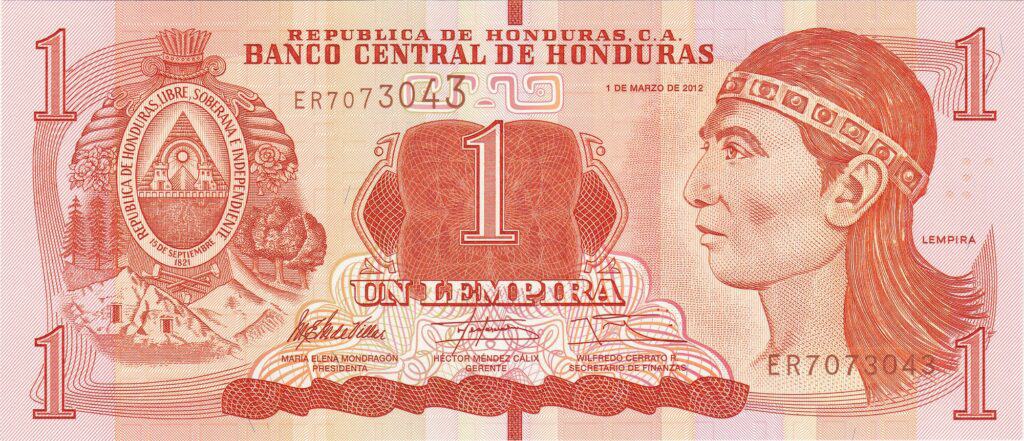
The 1 lempira note is red and depicts Lempira on the front and the Copán ruins on the back.
2L
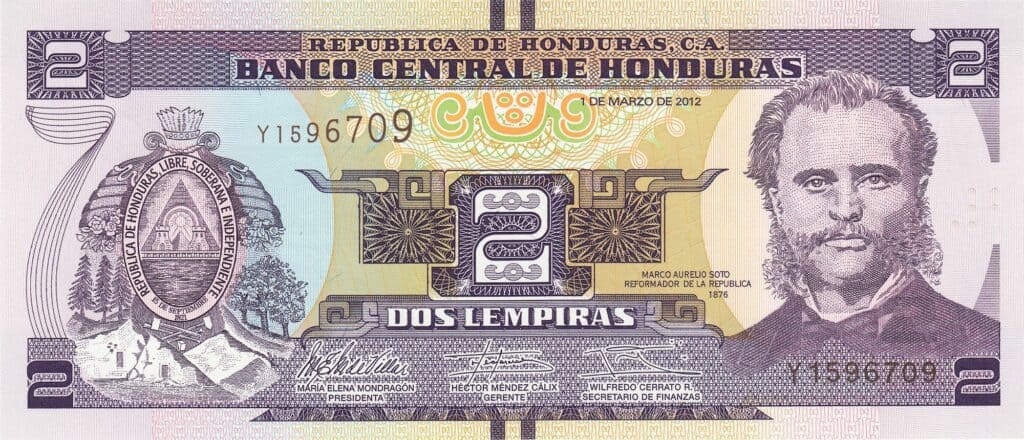
The 2 lempira note is purple, showing Marco Aurelio Soto on the front and Amapala on the back.
5L
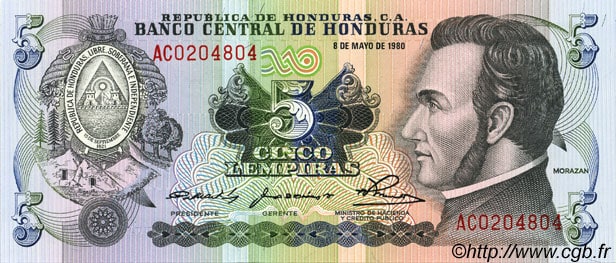
A 5 lempira note is gray, featuring Francisco Morazán on the front and the Battle of La Trinidad on the back.
10L
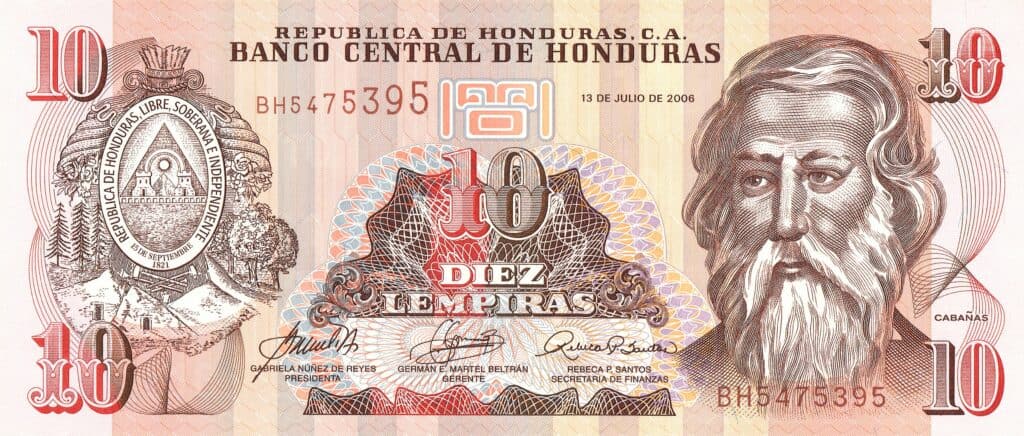
The 10 lempira note is brown, with José Trinidad Cabañas on the front and the Universidad Nacional Autónoma de Honduras on the back.
20L
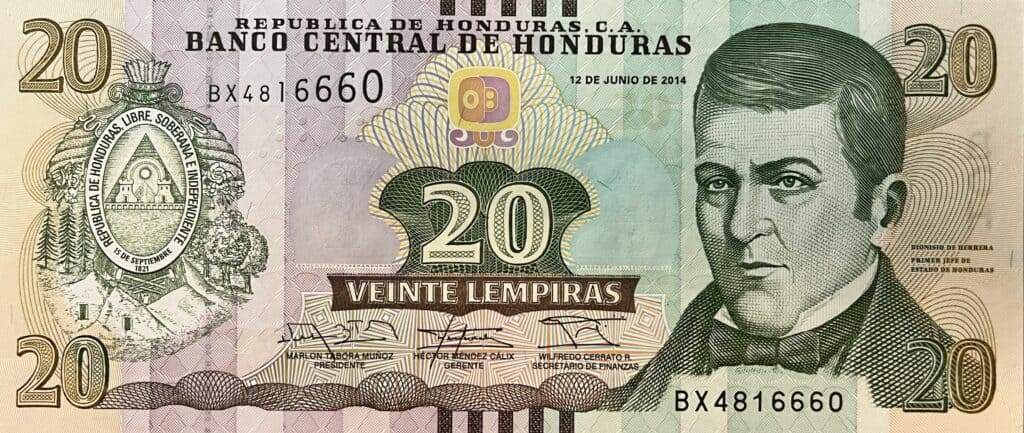
The 20 lempira note is green, depicting Dionisio de Herrera on the front and the Presidential Palace on the back.
50L
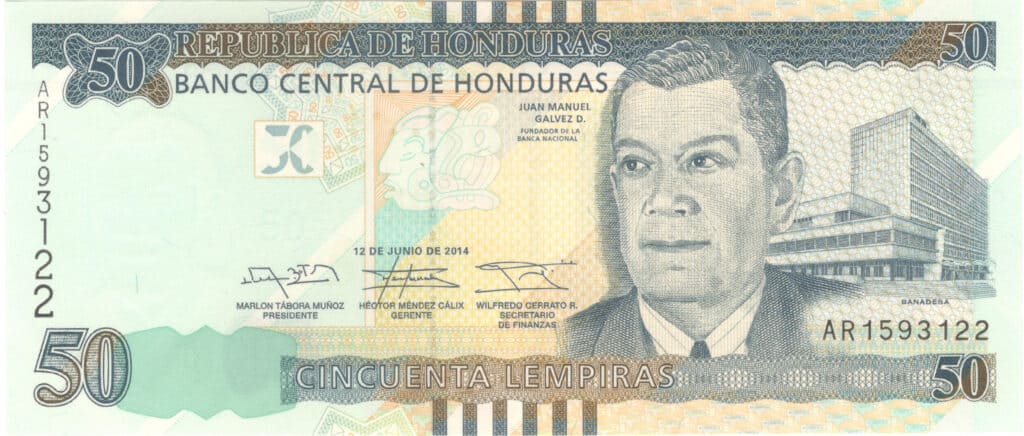
A 50 lempira note is blue, showing Juan Manuel Gálvez on the front and the Central Bank of Honduras on the back.
100L
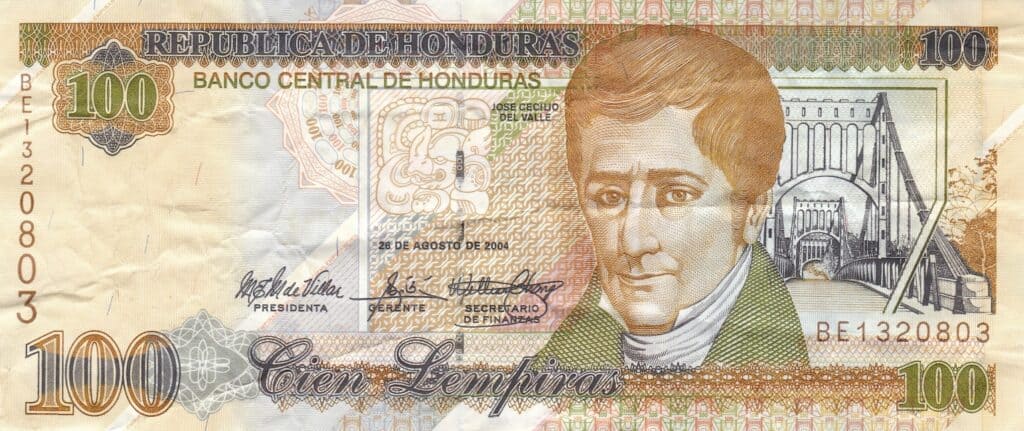
The 100 lempira note is orange, featuring José Cecilio del Valle on the front and Casa Valle on the back.
200L
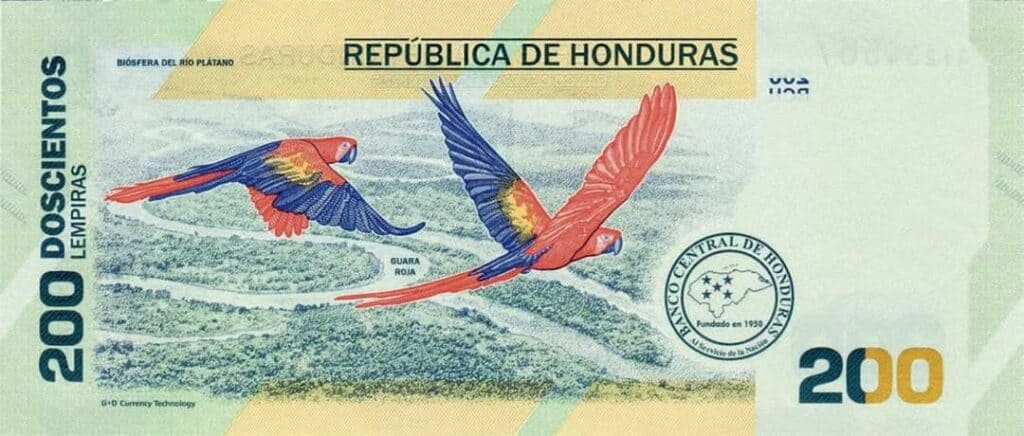
The 200 lempira note is turquoise, with two Scarlet Macaws on the front and the Banco Central de Honduras on the back.
500L
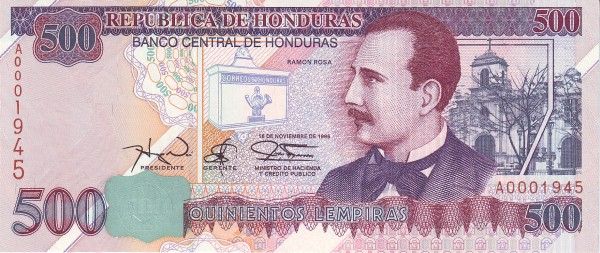
The 500 lempira note is violet, depicting Ramón Rosa on the front and San Juancito on the back.
Currency Usage in Honduras
Honduras has its own currency, the Honduran lempira (HNL), which is the official legal tender in the country. You can use it to settle all financial obligations in the country, including paying for goods, services, taxes, and debts.
Bills come in denominations of 1, 2, 5, 10, 20, 50, 100, 200, and 500. Coins come in denominations of 5, 10, 20, and 50 centavos.
Is USD accepted in Honduras?
While the official currency in Honduras is the Honduran lempira, USD is widely accepted in the country. However, it is important to note that you may not always get the best exchange rate when using USD to pay for goods and services.
Additionally, some vendors may not accept USD at all, so it is always a good idea to carry some lempiras with you.
In Honduras, the lempira is the only currency that is accepted as legal tender. It is important to note that while some businesses may accept US dollars, it is not guaranteed, and you may receive change in lempiras.
Additionally, some businesses may not accept credit cards, so it is a good idea to carry cash with you at all times.
If you need to exchange USD for lempiras, you can do so at banks, exchange houses, and some hotels. It is recommended to exchange money at reputable establishments to avoid scams and counterfeit currency.
Overall, it is best to have some lempiras on hand when traveling in Honduras to ensure that you can pay for everything you need without any issues.
Exchanging Currency in Honduras
If you’re planning a trip to Honduras, you’ll need to know how to exchange your currency for Honduran lempira (HNL). Here are some things to keep in mind when exchanging currency in Honduras.
Where can I exchange Honduran currency?
You can exchange currency at banks, exchange bureaus, and some hotels in Honduras. Banks are generally the most reliable and secure option for currency exchange. Some popular banks in Honduras include Banco Atlántida, Banco de Occidente, and Banco Ficohsa.
Exchange bureaus are another option, but they may charge higher fees than banks. It’s important to compare exchange rates and fees before choosing a bureau.
You can also exchange currency at some hotels, but they may offer less favorable rates than banks and bureaus.
What to know before exchanging currency in Honduras
Before exchanging your currency, here are a few things to keep in mind:
- Check the exchange rate: Make sure you know the current exchange rate for your currency to HNL. You can check the current exchange rate online at sites like XE or Wise.
- Bring cash: Many places in Honduras, especially outside of major cities, may not accept credit cards or other forms of electronic payment. It’s a good idea to bring cash with you and exchange it as needed.
- Bring US dollars: US dollars are widely accepted in Honduras, and many places may even prefer them to HNL. However, be aware that some places may not accept bills that are torn or damaged in any way.
- Beware of scams: Be cautious when exchanging currency in Honduras, as there are some scams to watch out for. For example, some exchange bureaus may advertise a great exchange rate, but then charge high fees that cancel out the savings. Stick with reputable banks and exchange bureaus to avoid scams.
By keeping these tips in mind, you can exchange your currency safely and efficiently in Honduras.
Choosing Between USD and Honduran Lempiras
If you’re planning to travel to Honduras, you may be wondering whether to bring US dollars or exchange your currency for Honduran lempiras. Here are some factors to consider when choosing between USD and Honduras currency.
Exchange Rate
The exchange rate between the US dollar (USD) and the Honduran lempira (HNL) can change, affecting the value of currency exchanges. It’s essential to consider these rate changes when planning to exchange money.
Additionally, exchanging currency might come with transaction fees, so it’s important to include these costs when evaluating the best exchange rates.
Convenience
Using US dollars in Honduras can be convenient, especially in tourist areas where many businesses accept dollars. However, using the local currency can be more convenient in other areas where businesses may not accept dollars or may offer unfavorable exchange rates.
Fees
If you choose to exchange your currency for Honduran lempiras, be aware that exchange bureaus may charge fees or offer unfavorable exchange rates.
Additionally, some banks may charge fees for using your debit or credit card in a foreign country. It’s a good idea to check with your bank before you travel to see what fees may apply.
Tips
If you choose to use US dollars in Honduras, be sure to bring small bills. Many businesses may not be able to make changes for large bills, and you may end up overpaying for small purchases.
Additionally, be aware that some businesses may offer a lower exchange rate for large bills.
In summary, whether you choose to use US dollars or Honduran lempiras depends on your personal preferences and needs. Consider the exchange rate, convenience, fees, and tips when making your decision.
Cost of Living in Honduras
If you’re planning to move to Honduras, it’s important to have an idea of the cost of living in the country. The cost of living in Honduras is generally lower than in most developed countries, but it can vary depending on the city you’re in and your lifestyle.
Housing costs in Honduras are generally lower than in most developed countries. The cost of renting an apartment in a city center can range from $250 to $500 per month while renting a one-bedroom apartment outside the city center can cost between $150 to $300 per month.
If you’re planning to buy property in Honduras, the cost of a one-bedroom apartment can range from $30,000 to $50,000.
Food costs in Honduras are generally lower than in most developed countries. The cost of a meal in an inexpensive restaurant can range from $3 to $6, while a three-course meal for two people in a mid-range restaurant can cost around $25.
If you’re planning to cook your food, the cost of groceries for a week can range from $20 to $50.
Transportation costs in Honduras are generally lower than in most developed countries. The cost of a one-way ticket on local transport can range from $0.25 to $0.50, while a monthly pass can cost around $30. If you’re planning to rent a car, the cost can range from $25 to $50 per day.
Other costs in Honduras can include entertainment, clothing, and personal care items. The cost of a movie ticket can range from $4 to $8, while the cost of a gym membership can range from $20 to $50 per month. The cost of clothing and personal care items can vary depending on the brand and quality.
Overall, the cost of living in Honduras is generally lower than in most developed countries. However, it’s important to keep in mind that the cost of living can vary depending on the city you’re in and your lifestyle.
Don’t Get Scammed Tips
When traveling to Honduras, it’s important to be aware of the potential scams that can occur when exchanging currency. Here are a few tips to help you avoid getting scammed:
1. Use reputable exchange services
Make sure to use reputable exchange services when converting your currency. Avoid exchanging money with street vendors or unlicensed individuals, as they may offer rates that are too good to be true and end up giving you counterfeit bills.
2. Check the exchange rate
Before exchanging your currency, check the current exchange rate to make sure you’re getting a fair deal. You can use online currency converters or check with your bank to get an idea of the current rate.
3. Count your money before leaving
Always count your money before leaving the exchange office. Make sure you receive the correct amount and that the bills are not torn or damaged. If you notice any issues, bring them to the attention of the exchange office immediately.
4. Don’t exchange currency in public places
Avoid exchanging currency in public places, such as airports or bus stations. These areas are often targeted by scammers who may try to distract you or steal your money.
5. Be cautious with ATMs
Be cautious when using ATMs, as skimming devices and other scams can be used to steal your card information. Use ATMs located in well-lit areas and inside banks or other secure locations.
By following these tips, you can help protect yourself from currency scams when traveling to Honduras.

